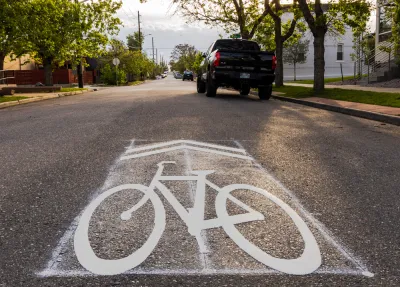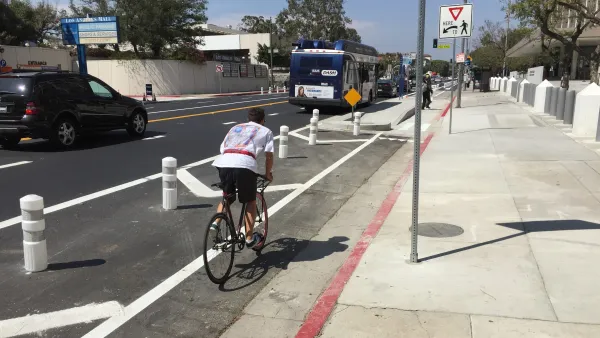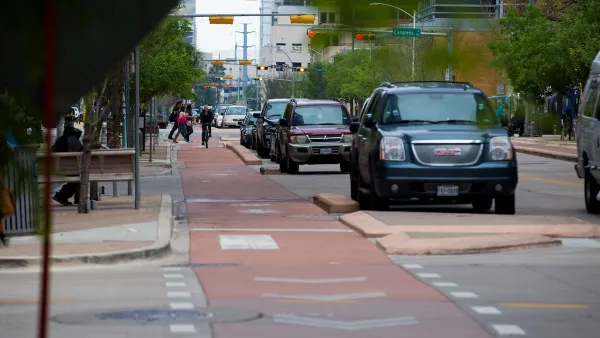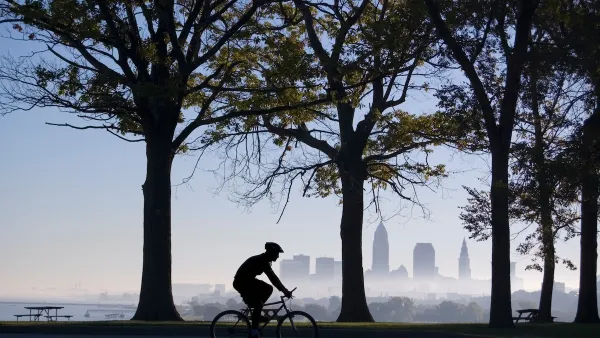The painted symbols can not only fail to protect bike riders, but can actually make riding conditions less safe.

An article written by Momentum Magazine staff argues that sharrows, once believed to be an effective way to remind drivers to share the road with bikes, are at best ineffective and at worst downright dangerous.
If you’re unfamiliar with these sad, lonely symbols, they’re those little bike-shaped icons painted onto roads that are supposed to indicate where cyclists should ride. But in reality, they’re about as effective as trying to protect yourself from a charging rhino with a wet paper towel.
According to the article, “Studies have shown that sharrows don’t actually provide any real safety benefits for cyclists. In fact, they may even make things worse by encouraging drivers to pass cyclists too closely.” Planetizen previously covered this shift in mindset, when People For Bikes senior director Dave Snyder admitted in an opinion piece that he “was wrong” when he enthusiastically supported sharrows decades ago.
“Time and time again, research demonstrates that sharrows are ineffective at improving cyclist safety.” In fact, “We know now that even actual bike lanes painted in some eye-catching hue do not provide enough safety for cyclists.” In the worst cases sharrows can engender a “false sense of security” and encourage drivers to pass too closely and cyclists to ride too close to parked cars.
As bike advocates regularly explain, “The best bicycle infrastructure for safe cycling is dedicated bike lanes that provide physical separation between cyclists and vehicles,” which can reduce the risk of injury for cyclists by as much as 90 percent, according to one study. Bike lanes are also shown to boost sales for local businesses, and naturally reduce carbon emissions when replacing car trips. As Snyder and other advocates argue, cities should invest in bike infrastructure that truly protects bike riders, other street users, and the environment.
FULL STORY: Sharrows used to make sense in theory, but are now useless and possibly dangerous in practice

Analysis: Cybertruck Fatality Rate Far Exceeds That of Ford Pinto
The Tesla Cybertruck was recalled seven times last year.

National Parks Layoffs Will Cause Communities to Lose Billions
Thousands of essential park workers were laid off this week, just before the busy spring break season.

Retro-silient?: America’s First “Eco-burb,” The Woodlands Turns 50
A master-planned community north of Houston offers lessons on green infrastructure and resilient design, but falls short of its founder’s lofty affordability and walkability goals.

Test News Post 1
This is a summary

Analysis: Cybertruck Fatality Rate Far Exceeds That of Ford Pinto
The Tesla Cybertruck was recalled seven times last year.

Test News Headline 46
Test for the image on the front page.
Urban Design for Planners 1: Software Tools
This six-course series explores essential urban design concepts using open source software and equips planners with the tools they need to participate fully in the urban design process.
Planning for Universal Design
Learn the tools for implementing Universal Design in planning regulations.
EMC Planning Group, Inc.
Planetizen
Planetizen
Mpact (formerly Rail~Volution)
Great Falls Development Authority, Inc.
HUDs Office of Policy Development and Research
NYU Wagner Graduate School of Public Service




























